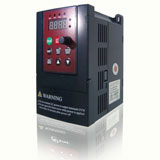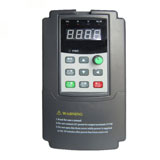HomeFAQ
For example if an intelligently and adequately designed mission critical multiple pump system with built in redundancy and backup is to be redesigned to utilize variable frequency system process control it follows that to continue to meet the mission critical aspects of the system design that the duty pump, the stand by pump and the backup maintenance pump (a common arrangement for public water supply utilities) should all have frequency inverters fitted. It will not deliver on mission criticality if only one frequency inverter is employed and switched between the three pumps. It would be foolish to think that only pumps fail, in this case if mission critical backup is required then that also applies to the frequency inverters, the associated switchgear and the control system.
These guidelines dispel the confusion about matching Frequency inverters (Variable frequency drive) and motors to fans and pumps that are typically encountered in commercial building applications. While the motivation to increase energy efficiency could be financial (reduced energy costs) or ethical (reduce greenhouse gas emissions associated with power production), it is taken for granted that frequency inverters are an easy way to improve energy efficiency in a motor application. And with these noble intentions in mind, the engineer will specify a frequency inverter for his client. Oftentimes, that isn't the end of the story for the engineer.
A frequency inverter changes output voltage frequency and magnitude to vary the speed, power, and torque of a connected induction motor to meet load conditions. A typical frequency inverter consists of three primary sections
To understand what is Reactive power is utmost important for all electrical engineers. Just go to basics of alternate. and basic definition of power P (watts)= V volts (ie Joules/ coulomb ) X I Amps (ie coulomb /sec) = V x I (joules/sec =watts) For Dc system frequency = 0 hence inductive reactance is zero and capacitive reactance is infinity hence only resistive loads dissipates power, mainly in the active is visible form of heat or used for motive load /lighting. this power is conventionally called active power.
1. How much process flow and pressure requirement through AC motors
2. Existing control methodology like control valve in pumps, Damper or guide vane for Fans & Blowers etc. and position of the valve or dampers
3. If you have process flow and pressure data and pump or fan design data, you can calculate energy saving using affinity law
4. Loading and Unloading cycle for compressor application. If the unloading time is higher for compressor application, you will get better energy saving
5. Using affinity law, you can calculate the energy saving with consideration of frequency inverter losses. With this you can calculate the Pay back of the inverters.
There are different ways you can use frequency inverter or soft starter to reduce your energy bill. Carefully analyses the possibilities of your plant.
2. Existing control methodology like control valve in pumps, Damper or guide vane for Fans & Blowers etc. and position of the valve or dampers
3. If you have process flow and pressure data and pump or fan design data, you can calculate energy saving using affinity law
4. Loading and Unloading cycle for compressor application. If the unloading time is higher for compressor application, you will get better energy saving
5. Using affinity law, you can calculate the energy saving with consideration of frequency inverter losses. With this you can calculate the Pay back of the inverters.
There are different ways you can use frequency inverter or soft starter to reduce your energy bill. Carefully analyses the possibilities of your plant.
The frequency inverter main advantage is saving electricity, saving rate depends on the application and running time.
The other advantage is protecting the electric motor, you can see if a high power machine start, other machines will be effected like low voltage.
After you use frequency inverter to control the motor, the power grid line is more stable and no instantaneous current shock to the electric motor.
The other advantage is protecting the electric motor, you can see if a high power machine start, other machines will be effected like low voltage.
After you use frequency inverter to control the motor, the power grid line is more stable and no instantaneous current shock to the electric motor.
Which inverter is best is a matter of application, cost, ROI and experience. The short answer is, "It depends."
In the PV business Sting Inverters make totally sense for example for roof top and car pool applications because there are lighter and smaller. You can normally install those inverters without large tools like a crane or something like that.
In the PV business Sting Inverters make totally sense for example for roof top and car pool applications because there are lighter and smaller. You can normally install those inverters without large tools like a crane or something like that.
What is more important in a frequency inverter? Ac line reactor or a DC choke? If Ac line reactor is missing what are its possible impacts? What if DC choke is missing?
AC line reactors reduce current harmonics on AC line which is caused by rectifier, while DC choke deal with DC bus current.
AC line reactors reduce current harmonics on AC line which is caused by rectifier, while DC choke deal with DC bus current.
 High quality frequency inverters for electric motor speed controls in energy-saving solutions.
High quality frequency inverters for electric motor speed controls in energy-saving solutions.
Search inverters
Category
inverters
Featured
 Single phase inverter normally is for small power electric motor speed adjustment applications, with single phase 220V to 240V input to three phase voltage ...
Single phase inverter normally is for small power electric motor speed adjustment applications, with single phase 220V to 240V input to three phase voltage ...
 This frequency inverter supplied by our factory integrated vector control function. This inverter can continuous running even if power supply off for a few ...
Frequency inverter manufacturers mainly focus on R&D in order to develop new and improved products, which offer more distinguished and revolutionary features ...
A frequency inverter changes output voltage frequency and magnitude to vary the speed, power, and torque of a connected induction motor to meet load conditions. ...
Frequency inverter reconstruction of Power Plant promoted heightening of economy benefit. Frequency inverter won acceptance of user as its high reliability, ...
Gozuk inverters are suitable in the fields of power, iron and steel, HVAC, oil, mine, construction, etc for the high-voltage motor's speed adjustment, energy ...
When adopting the frequency inverter to conduct speed adjustment, the fan speed will reduce from N1 to N2. As the fan's static pressure Pst=0, conforming to ...
This frequency inverter supplied by our factory integrated vector control function. This inverter can continuous running even if power supply off for a few ...
Frequency inverter manufacturers mainly focus on R&D in order to develop new and improved products, which offer more distinguished and revolutionary features ...
A frequency inverter changes output voltage frequency and magnitude to vary the speed, power, and torque of a connected induction motor to meet load conditions. ...
Frequency inverter reconstruction of Power Plant promoted heightening of economy benefit. Frequency inverter won acceptance of user as its high reliability, ...
Gozuk inverters are suitable in the fields of power, iron and steel, HVAC, oil, mine, construction, etc for the high-voltage motor's speed adjustment, energy ...
When adopting the frequency inverter to conduct speed adjustment, the fan speed will reduce from N1 to N2. As the fan's static pressure Pst=0, conforming to ...
Recent
60Hz to 50Hz Frequency Converter
50Hz motor running on 60Hz power supply
Single phase to three phase converter
Frequency converter typical shortcomings
Frequency Converter Troubleshooting
Frequency inverter, the best energy saving solution
Does Frequency converter better than control valves in flow controls
Frequency Converter for Pumps
Why AC motor needs a Frequency Converter?
Determining frequency converter size
Frequency inverter energy efficiency calculation
Frequency inverter for heavy duty application (mining)
50Hz motor running on 60Hz power supply
Single phase to three phase converter
Frequency converter typical shortcomings
Frequency Converter Troubleshooting
Frequency inverter, the best energy saving solution
Does Frequency converter better than control valves in flow controls
Frequency Converter for Pumps
Why AC motor needs a Frequency Converter?
Determining frequency converter size
Frequency inverter energy efficiency calculation
Frequency inverter for heavy duty application (mining)
